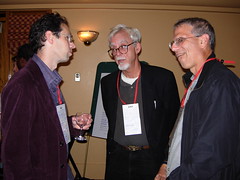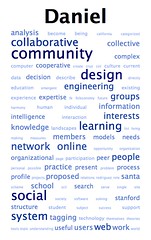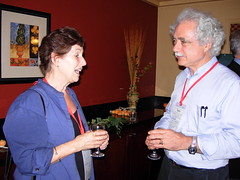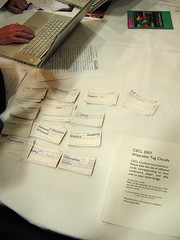Tonight, TagCrowd made its (physical) world debut at a Stanford faculty retreat in Half Moon Bay. I created a name tag for each professor by dropping their research statements and resumes into TagCrowd to create a cloud visualization of their interests, projects, collaborators and activities.
It was a hit.
The primary goal of these personal visualizations was to facilitate the formation of new collaborative research teams on the basis of shared interest. By making interests mutually visible when people meet each other for the first time, these “name tag clouds” can identify areas of overlap, complementary expertise, and opportunities for potential collaboration — all in a brief glance. They also serve as conversational props that ease the introduction process: the clouds present conversants a rich set of topics for inquiry.

Looking around the room at any given time I witnessed circles of intellectual elites huddled intimately together, pointing playfully at one another’s clouds. Lera Boroditsky said that virtually every conversation she was in was about the cloud or referred to it.
At right: Dan Jurafsky, John Perry & Tom Wasow chat it up at the cocktail party with their clouds around their necks.
I saw some of the brightest minds in the world with child-like grins and heads tilted navel-ward to see the constellation of words and concepts that others were seeing: the alphabetic poetry of their lives scrawled across their hearts, as it were.

Here is my own name tag from the event. As far as I know, this is the first application of tag clouds in a face-to-face community.
I got a lot of good feedback from the participants. In general people were impressed by how representative the clouds were.
The most common request was the wish to see a time-lapse animation of how the cloud visualization of one’s research interests evolves over the span of a career. Jeremy Bailenson suggested that color could be used to represent the time dimension even on a static picture like a name tag. My latest interests would shine red hot, regardless of size. Past passions would loom large and cool.

Terry Winograd (pictured at right with Eve Clark) had one of the most valuable pieces of user-experience feedback when he told me that he needed his glasses to read peoples’ clouds. He’s far-sighted and so it does no good to just get closer. Note to self: bigger words, fewer words.
Thanks, Terry. And thanks to all of you for taking part and having fun doing it. I got such a kick out of it, I can’t even tell you.




